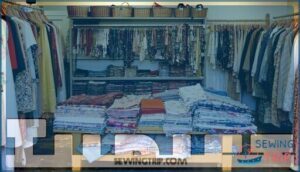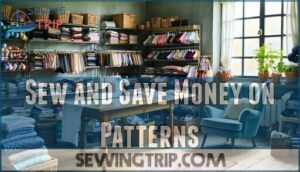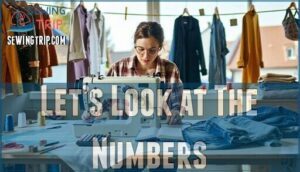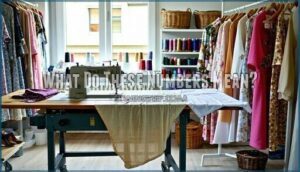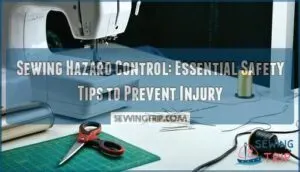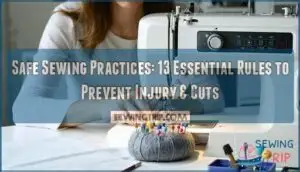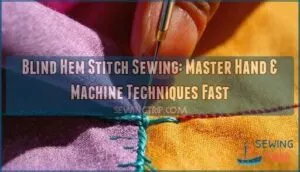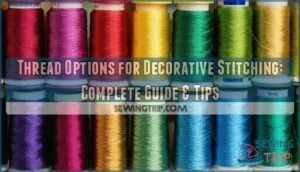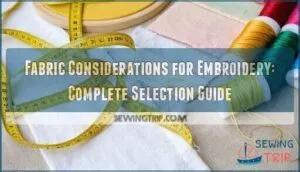This site is supported by our readers. We may earn a commission, at no cost to you, if you purchase through links.
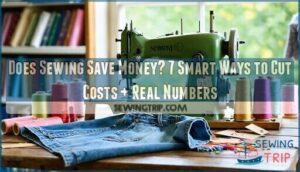 Does sewing save money? It depends on your approach.
Does sewing save money? It depends on your approach.
While fast fashion makes cheap clothes accessible, sewing can absolutely save you cash if you’re strategic. You’ll need to invest upfront in fabric, notions, and tools, but the real savings come from smart shopping habits and choosing the right projects.
A homemade pair of jeans might cost $25-40 versus $80-150 for quality store-bought ones. However, if you’re buying premium fabrics for simple garments, you might spend more than retail prices.
The key is understanding when to sew versus when to buy, plus mastering cost-cutting techniques that seasoned sewists swear by, which can help you make the most of your sewing and save money in the long run with the right approach.
Table Of Contents
Key Takeaways
- You’ll save money when you’re strategic – Focus on higher-value items like jeans ($25-40 homemade vs $80-150 retail) and jackets, while avoiding simple garments that cost more to make than to buy
- Shop your stash first and thrift smart – Use existing fabric before buying new, hunt for remnants at manufacturers, and check thrift stores for materials like sheets and curtains that offer generous yardage at rock-bottom prices
- Invest in versatile patterns over impulse buys – Buy paper patterns during sales for $1 each, use free patterns to build skills, and learn pattern alteration techniques to transform one pattern into multiple garments
- Factor in your time and skill level – Beginners will not save money initially due to startup costs and mistakes, but experienced sewists can slash clothing budgets by 60-80% through efficient techniques and smart fabric sourcing
Is Sewing an Expensive Hobby?
When you think about sewing cost versus buying ready-made clothes, the numbers might surprise you.
Sure, your initial hobby budget seems steep with fabric costs, thread, and that new machine calling your name.
But here’s the thing – sewing saves money in ways that aren’t obvious at first glance.
Your sewing skills improve over time, making each project more efficient and reducing material waste.
That time investment pays off when you’re cranking out quality pieces for pennies on the dollar.
Plus, you’re not stuck with fast fashion that falls apart after three washes.
The real magic happens when you start thinking long-term about your sewing expenses versus shopping.
Those sewing savings add up fast, especially when you master thrifting for supplies and working with what you’ve got.
Your sewing budget becomes an investment in freedom from overpriced retail markup.
Understanding the concept of sewing budget is essential to making the most of your hobby and minimizing unnecessary expenses.
Sew and Save Money on Fabric, Notions, Tools, and Machines
Your fabric budget doesn’t have to break the bank if you know where to look and how to shop smart.
Let’s explore five proven strategies that’ll help you build an impressive fabric stash without emptying your wallet.
Sew Your Stash
Your fabric stash is treasure waiting to be discovered. Start by shopping your existing collection before heading to the store – you’ll be amazed at what forgotten gems you’ll find.
Your fabric stash is treasure waiting to be discovered—shop your collection first!
Fabric recycling through stash management transforms scraps into stunning projects while boosting sewing efficiency. Repurposing tips like salvaging zippers from old jackets or combining leftover fabrics create unique pieces.
This sustainable sewing approach proves that sewing saves money when you maximize your sewing stash first. Smart fabric stash planning reduces sewing cost while increasing sewing savings through creative resourcefulness.
Effective sewing fabric selection involves considering the type of sewing fabric needed for each project, which is a key part of sewing efficiency and helps in creative resourcefulness.
Don’t Buy Something Only Because It’s on Sale
Sales can be financial quicksand for frugal sewing enthusiasts.
When fabric hits clearance, your brain screams "buy now!" but smart shopping means resisting impulse purchases. Mindful buying trumps bargain hunting every time.
That discounted fabric becomes expensive clutter if it sits unused. Budget-friendly sewing requires discipline—only purchase materials with specific projects planned.
Cost-effective sewing isn’t about hoarding cheap fabric; it’s about strategic fabric budgeting. Sale strategies should align with your actual needs, not wishful thinking.
Saving money on sewing costs starts with saying no to tempting deals without purpose, which requires mindful buying and a focus on cost-effective decisions.
Watch for Other Sewists to Sell Their Stashes
Smart sewists know that treasure often hides in someone else’s stash. Connect with your local sewing community and watch online marketplaces for sewist networking opportunities.
You’ll discover quality fabrics at a fraction of retail prices when fellow makers destash their collections.
Here’s where to find these sewing savings tips:
- Facebook sewing groups – Search "sewing stash sale" in your area
- Instagram hashtags – Follow #destash and #fabricsale posts
- Local guild meetings – Members often bring excess materials to share
- Online sewing forums – Check marketplace sections for deals
- Nextdoor app – Neighbors frequently sell craft supplies
This sewing thrifty approach connects you with quality materials while supporting fellow makers.
Search for Nearby Manufacturers or Warehouses and Ask if They’ll Sell You Remnants
Local manufacturers and warehouses often sell fabric remnants at steep discounts, turning your sewing savings into serious wins.
These hidden gems offer high-quality discount textiles that retail stores can’t match. Buying fabric remnants online can also expand your options for affordable materials.
- Contact local apparel manufacturers about remnant sales
- Search online for warehouse sales and fabric outlet events
- Visit textile districts in nearby cities for wholesale opportunities
- Check manufacturing facilities for overstock and repurposed materials
Thrift
Your local thrift stores are treasure troves for budget-conscious sewists.
They offer a wide range of materials, including fabric remnants, vintage sheets, and curtains that provide generous yardage at rock-bottom prices.
Second hand textiles often cost under $5 compared to $15+ per yard retail.
Look beyond clothing racks—tablecloths make excellent fabric for upcycling projects.
Salvage buttons, zippers, and notions from worn garments for future refashioning adventures.
Thrifting transforms fabric recycling into creative repurposing while saving money sustainably.
By adopting a fabric budget plan, sewists can make the most of their thrift store finds and reduce waste.
Sew and Save Money on Patterns
Patterns can eat up your sewing budget fast, but smart shoppers know how to build a huge collection without breaking the bank.
Let’s explore five strategies that’ll keep your pattern stash growing while your wallet stays happy.
This is Kind of Controversial, but Don’t Buy PDF Patterns on Sale
That "buy now" button might seem like a golden ticket, but here’s the truth about PDF patterns on sale.
Over 60% of sewists accumulate unused digital patterns, creating costly clutter instead of sewing savings.
Pattern budgeting means buying only what you’ll actually use within six months, and those flash sales trigger impulse purchases that derail your sewing strategy.
Focus on fabric sourcing and versatile patterns instead, as smart sewing economics means investing in quality over quantity for cost-effective sewing results.
Do Buy Paper Patterns on Sale
Paper patterns during pattern sales can be your secret weapon for slashing sewing costs without sacrificing quality.
Unlike their digital counterparts, these tangible templates offer incredible value when you snag them at major retailers for just $1 each during promotional events.
Here’s how to maximize your fabric budget through strategic discount shopping:
- Stock up during mega sales – Major pattern companies offer deep discounts several times yearly, turning $15+ patterns into dollar deals
- Focus on versatile designs – Choose patterns with multiple views or basic silhouettes you’ll use repeatedly
- Check independent fabric stores – They often clearance discontinued patterns at rock-bottom prices
- Time your purchases – Back-to-school and post-holiday sales offer the best sewing deals
- Trade with other sewists – Exchange patterns you’ve outgrown for fresh designs
This frugal sewing approach lets you build a substantial pattern library without breaking the bank.
You’ll have endless options for future projects while keeping sewing costs manageable.
Smart pattern shopping means more money left for quality fabric and notions.
Use Free Patterns
You don’t need to spend a fortune on patterns when free options deliver excellent results.
The sewing community offers thousands of free patterns for everything from basic tops to complex jackets. These patterns help you master pattern alteration techniques while building your skills with DIY designs.
| Free Pattern Type | Best For |
|---|---|
| Basic tops & tees | Learning fundamentals |
| Accessories & bags | Quick weekend projects |
| Children’s clothing | Growing wardrobes |
| Sleepwear & loungewear | Comfort sewing |
Free tutorials accompanying these patterns teach fabric optimization and advanced techniques. Sewing communities share reviews, modifications, and troubleshooting tips that make these patterns as reliable as paid versions.
You’ll save money while discovering new designers and styles. Utilizing free sewing patterns found through sewing pattern resources can substantially expand your creative possibilities.
There Are Books Full of Patterns
Think of pattern books as your personal sewing library that won’t break the bank.
You’ll find dozens of sewing patterns packed into one affordable volume, making your cost per pattern incredibly low compared to buying individual designs.
Pattern books shine because they offer:
- Multiple garment construction techniques in one purchase
- Diverse textile design inspirations across various styles
- Comprehensive sewing techniques with detailed instructions
- Fabric selection guidance for each pattern variation
Libraries often stock these pattern books, so you can browse before buying.
Many feature timeless designs that you’ll use repeatedly, plus they’re perfect for learning pattern alteration skills since you’re not risking expensive individual patterns.
Understanding the cost per wear concept can also help you make informed decisions about your sewing projects.
Learn How to Alter Patterns and Combine Patterns
Learning pattern alteration and Sewing Hacks opens up endless possibilities for cost-effective sewing.
Instead of buying new patterns every time you want something different, you can transform existing ones through Style Modification techniques. Take a basic bodice pattern and combine it with sleeves from another—you’ve created something completely new without spending extra money.
Pattern Altering skills let you adjust fit, change necklines, or add design elements. This approach to sewing savings means one pattern becomes ten different garments.
Fabric Mixing becomes easier when you’re not locked into specific pattern requirements. You can redesign garments to work with whatever fabric you have on hand. This Garment Redesign approach maximizes your sewing economy while expressing your personal style.
Making Money While Sewing (without Having a Blog or Business)
While you’re spending money on sewing supplies, you can actually earn a bit back without starting a business or blog.
Apps like Ebates and Ibotta let you get cashback on purchases you’re already making, turning your hobby expenses into small savings that add up over time.
Use Ebates When Buying Online to Get Some Money Back
Online shopping for sewing supplies becomes more cost-effective when you harness cashback rewards through Ebates (now Rakuten).
This rebate program transforms every purchase into a money-saving opportunity by offering:
- Cashback rates of 2-6% on sewing retailers like Michaels and Singer
- Quarterly payouts via check or PayPal once you reach $5.01
- Browser extension alerts for available deals and digital coupons
- Stacked savings when combined with store sales and promo codes
Simply click through Rakuten before checkout to earn while you shop.
These sewing discounts add up quickly, making your hobby more budget-friendly.
For international shoppers, using a global shopping service can also help navigate complex purchases.
Use Ibotta When Buying in Big Box Stores
Big box stores like Walmart and Target become your secret weapon for slashing sewing costs when you use cashback apps like Ibotta.
This powerful app partners with over 3,000 retailers and delivers real money back on your purchases—not just points or store credit. Consider buying from sewists to find discounted or surplus materials.
| Store | Typical Cashback | Special Features |
|---|---|---|
| Walmart | $0.25-$2.00 per item | Direct account linking |
| Target | $0.25-$2.00 per item | Receipt scanning only |
| Costco | Varies by offer | Bulk purchase savings |
| Home Depot | Tool & supply offers | DIY project discounts |
Simply activate offers before shopping, then upload your receipt or link your loyalty account. The average user earns $256 annually, turning routine fabric and notion runs into money-making opportunities that offset your sewing costs.
Let’s Look at The Numbers
Now let’s crunch the numbers to see if sewing actually saves you money compared to buying clothes at the store.
I’ll break down real costs for popular items like jeans, shirts, jackets, leggings, and jumpsuits so you can make informed decisions about your sewing projects.
Jeans
Home sewing jeans can slash your clothing costs dramatically if you’re strategic about it. With stashed denim, you’re looking at zero material costs versus $71 for store-bought jeans. Even purchasing fabric keeps you under $30 total, while premium retail jeans hit $200+.
Strategic sewing with stashed denim turns zero material costs into serious savings versus $71 store-bought jeans.
- Denim types: Heavy-weight cotton denim offers durability; stretch denim provides comfort for everyday wear
- Jean construction: Flat-fell seams and bartacks at stress points guarantee longevity matching factory standards
- Fit alterations: Customize waist, inseam, and taper for perfect sizing unavailable in mass-produced options
- Hardware sourcing: Salvage rivets, buttons, and zippers from thrifted jeans to cut notion expenses
Your sewing costs drop further with each pair you make, spreading pattern and tool investments across multiple projects.
Button-up Shirts
Comparing sewing costs against retail prices reveals interesting truths about button-up shirts.
A Target boy’s plaid shirt costs just $10, while your homemade version requires $21-27 for fabric alone.
You’ll need thrifted fabric under $5 per yard to beat discount store pricing.
However, sewing clothes offers advantages beyond sewing savings.
Your fabric choice determines drape and durability.
Perfect shirt fittings create custom silhouettes impossible in ready-to-wear.
Mastering collar styles and button options elevates your garments.
These sewing tips transform basic patterns into crafted pieces.
While sewing costs exceed clothing prices at discount retailers, you’re investing in quality construction and personalized fit.
Jackets
Looking at jacket construction and fabric choices, you’ll find sewing jackets offers significant DIY savings compared to retail prices.
Quality materials cost $50-75, but your handmade piece lasts over a decade with proper care.
Smart cost analysis reveals three winning strategies:
- Thrifting outerwear for fabric repurposing
- Upcycling winter wear into fresh styles
- Altering existing coats for better fit.
Jacket patterns paired with strategic fabric choices make sewing clothes affordable while building expertise in outerwear construction.
Leggings
Those $50 designer leggings might tempt you, but DIY leggings reveal surprising sewing economics.
Cost analysis shows homemade leggings typically run $53-58 including fabric choices ($12-17), notions ($5), and labor costs.
Target’s $30 leggings often beat DIY pricing unless you’re using stash fabric or thrifted materials.
Legging patterns require 1.25-1.75 yards of stretch fabric, making fabric selection vital for sewing cost-saving.
Smart sewists prioritize fit over sewing affordability here—custom waistbands and perfect length justify the investment.
DIY leggings shine when repurposing old t-shirts or scoring clearance athletic fabrics, transforming clothing affordability through strategic sewing tips.
Jumpsuits
Jumpsuits pack serious DIY savings potential when you’re smart about fabric choice and jumpsuit patterns.
Target’s ready-to-wear averages $30, while your sewing costs hit $25-48 for fabric alone.
The real win is the custom fit and quality materials.
Hunt down free jumpsuit patterns online, thrift fabric from bed sheets, or grab remnants from manufacturers.
Mastering basic alterations and understanding proper sewing pattern basics is essential for achieving a professional finish, which contributes to sewing affordability.
What Do These Numbers Mean?
Breaking down sewing economics reveals some eye-opening truths about cost effectiveness.
When you factor in fabric, notions, patterns, and most importantly, your labor time at fair wages, home-sewn garments often exceed ready-to-wear prices.
A simple dress requiring five hours of work translates to $60-90 in labor costs alone.
However, these numbers don’t capture the full picture of DIY benefits.
You’re gaining perfect fit, superior fabric quality, and creative control that mass-produced clothing can’t match.
Smart budget planning through fabric savings and strategic sourcing can tip the scales in your favor.
The real cost analysis?
Sewing delivers value beyond mere dollars.
Frequently Asked Questions (FAQs)
Is it actually cheaper to sew your own clothes?
Your fabric stash is like a treasure chest – full of potential wealth waiting to be discovered.
Sewing can save you money, but it depends on your fabric choices, skill level, and what you’re making versus buying.
How does sewing save money?
You’ll save money by using fabric stash, thrifting materials, repurposing old clothes, and avoiding impulse purchases. Focus on quality basics, reuse notions, and shop your existing supplies first.
Is sewing an affordable hobby?
Like a double-edged sword, sewing cuts both ways financially.
Your startup costs and skill level determine affordability.
With smart fabric sourcing, thrifting, and using your stash, you’ll slash expenses substantially over time, which can lead to greater affordability.
Is it cheaper to get clothes stitched?
Getting clothes professionally stitched can be cost-effective if you’re using quality fabric and skilled tailors. You’ll save compared to high-end boutiques, but mass-produced clothing often beats custom tailoring costs.
Can beginners actually save money when starting to sew?
Don’t put all your eggs in one basket – beginners typically won’t save money initially.
You’ll need basic tools, fabric, and patterns, plus expect mistakes that waste materials.
Focus on learning first, savings come later.
What sewing skills make the biggest financial difference?
Learning alterations transforms your wardrobe economics—you’ll hem, take in, and resize thrifted finds instead of buying new.
Mastering basic repairs like patching and darning extends garment life dramatically, while pattern alterations maximize your existing collection’s versatility.
How much space do you need for cost-effective sewing?
Your sewing corner blooms wherever you plant it.
You’ll cut costs effectively with just a card table and good lighting.
Portable cutting mats, folding ironing boards, and stackable storage boxes maximize small spaces while keeping your budget-friendly projects flowing smoothly.
Are sewing classes worth the investment for saving money?
Classes can accelerate your skill development and help you avoid costly mistakes that waste fabric and time.
You’ll learn efficient techniques that reduce material waste and gain confidence to tackle projects that actually save money versus buying ready-made clothes, which can be a significant advantage in terms of saving money.
Conclusion
Ready sewists can slash their clothing budget by 60-80% with smart strategies, and the numbers prove it.
Does sewing save money? Absolutely, when you’re strategic about fabric choices and project selection.
By using your stash, hunting for remnants, and choosing higher-value garments like jeans and jackets, you’ll consistently beat retail prices.
The upfront investment pays dividends when you consistently apply these cost-cutting techniques.
Start with one money-saving tip and build from there.





